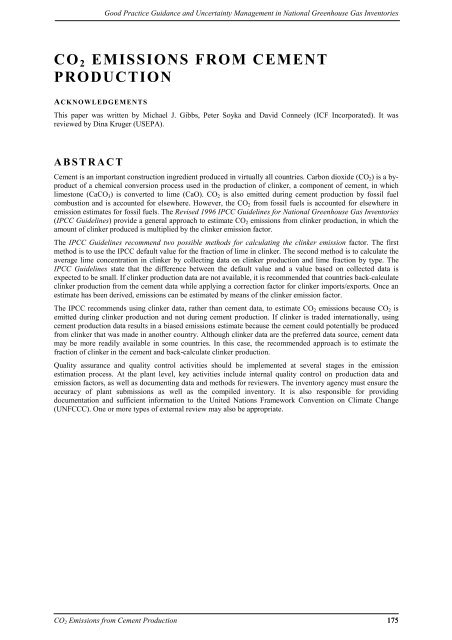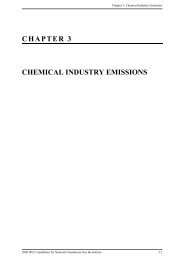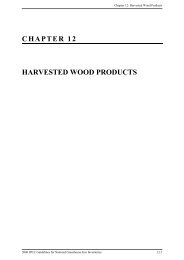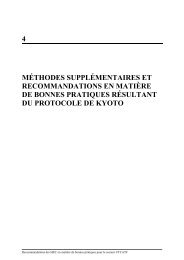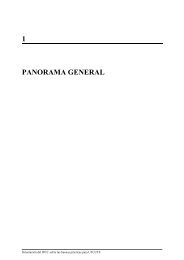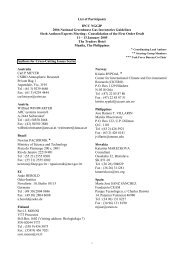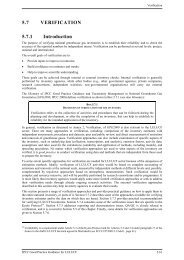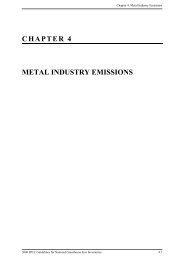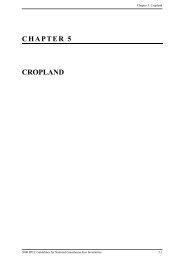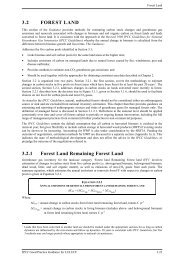co2 emissions from cement production - IPCC - Task Force on ...
co2 emissions from cement production - IPCC - Task Force on ...
co2 emissions from cement production - IPCC - Task Force on ...
You also want an ePaper? Increase the reach of your titles
YUMPU automatically turns print PDFs into web optimized ePapers that Google loves.
Good Practice Guidance and Uncertainty Management in Nati<strong>on</strong>al Greenhouse Gas Inventories<br />
CO2 EMISSIONS FROM CEMENT<br />
PRODUCTION<br />
ACKNOWLEDGEMENTS<br />
This paper was written by Michael J. Gibbs, Peter Soyka and David C<strong>on</strong>neely (ICF Incorporated). It was<br />
reviewed by Dina Kruger (USEPA).<br />
ABSTRACT<br />
Cement is an important c<strong>on</strong>structi<strong>on</strong> ingredient produced in virtually all countries. Carb<strong>on</strong> dioxide (CO2) is a byproduct<br />
of a chemical c<strong>on</strong>versi<strong>on</strong> process used in the <str<strong>on</strong>g>producti<strong>on</strong></str<strong>on</strong>g> of clinker, a comp<strong>on</strong>ent of <str<strong>on</strong>g>cement</str<strong>on</strong>g>, in which<br />
limest<strong>on</strong>e (CaCO3) is c<strong>on</strong>verted to lime (CaO). CO2 is also emitted during <str<strong>on</strong>g>cement</str<strong>on</strong>g> <str<strong>on</strong>g>producti<strong>on</strong></str<strong>on</strong>g> by fossil fuel<br />
combusti<strong>on</strong> and is accounted for elsewhere. However, the CO2 <str<strong>on</strong>g>from</str<strong>on</strong>g> fossil fuels is accounted for elsewhere in<br />
emissi<strong>on</strong> estimates for fossil fuels. The Revised 1996 <str<strong>on</strong>g>IPCC</str<strong>on</strong>g> Guidelines for Nati<strong>on</strong>al Greenhouse Gas Inventories<br />
(<str<strong>on</strong>g>IPCC</str<strong>on</strong>g> Guidelines) provide a general approach to estimate CO2 <str<strong>on</strong>g>emissi<strong>on</strong>s</str<strong>on</strong>g> <str<strong>on</strong>g>from</str<strong>on</strong>g> clinker <str<strong>on</strong>g>producti<strong>on</strong></str<strong>on</strong>g>, in which the<br />
amount of clinker produced is multiplied by the clinker emissi<strong>on</strong> factor.<br />
The <str<strong>on</strong>g>IPCC</str<strong>on</strong>g> Guidelines recommend two possible methods for calculating the clinker emissi<strong>on</strong> factor. The first<br />
method is to use the <str<strong>on</strong>g>IPCC</str<strong>on</strong>g> default value for the fracti<strong>on</strong> of lime in clinker. The sec<strong>on</strong>d method is to calculate the<br />
average lime c<strong>on</strong>centrati<strong>on</strong> in clinker by collecting data <strong>on</strong> clinker <str<strong>on</strong>g>producti<strong>on</strong></str<strong>on</strong>g> and lime fracti<strong>on</strong> by type. The<br />
<str<strong>on</strong>g>IPCC</str<strong>on</strong>g> Guidelines state that the difference between the default value and a value based <strong>on</strong> collected data is<br />
expected to be small. If clinker <str<strong>on</strong>g>producti<strong>on</strong></str<strong>on</strong>g> data are not available, it is recommended that countries back-calculate<br />
clinker <str<strong>on</strong>g>producti<strong>on</strong></str<strong>on</strong>g> <str<strong>on</strong>g>from</str<strong>on</strong>g> the <str<strong>on</strong>g>cement</str<strong>on</strong>g> data while applying a correcti<strong>on</strong> factor for clinker imports/exports. Once an<br />
estimate has been derived, <str<strong>on</strong>g>emissi<strong>on</strong>s</str<strong>on</strong>g> can be estimated by means of the clinker emissi<strong>on</strong> factor.<br />
The <str<strong>on</strong>g>IPCC</str<strong>on</strong>g> recommends using clinker data, rather than <str<strong>on</strong>g>cement</str<strong>on</strong>g> data, to estimate CO2 <str<strong>on</strong>g>emissi<strong>on</strong>s</str<strong>on</strong>g> because CO2 is<br />
emitted during clinker <str<strong>on</strong>g>producti<strong>on</strong></str<strong>on</strong>g> and not during <str<strong>on</strong>g>cement</str<strong>on</strong>g> <str<strong>on</strong>g>producti<strong>on</strong></str<strong>on</strong>g>. If clinker is traded internati<strong>on</strong>ally, using<br />
<str<strong>on</strong>g>cement</str<strong>on</strong>g> <str<strong>on</strong>g>producti<strong>on</strong></str<strong>on</strong>g> data results in a biased <str<strong>on</strong>g>emissi<strong>on</strong>s</str<strong>on</strong>g> estimate because the <str<strong>on</strong>g>cement</str<strong>on</strong>g> could potentially be produced<br />
<str<strong>on</strong>g>from</str<strong>on</strong>g> clinker that was made in another country. Although clinker data are the preferred data source, <str<strong>on</strong>g>cement</str<strong>on</strong>g> data<br />
may be more readily available in some countries. In this case, the recommended approach is to estimate the<br />
fracti<strong>on</strong> of clinker in the <str<strong>on</strong>g>cement</str<strong>on</strong>g> and back-calculate clinker <str<strong>on</strong>g>producti<strong>on</strong></str<strong>on</strong>g>.<br />
Quality assurance and quality c<strong>on</strong>trol activities should be implemented at several stages in the emissi<strong>on</strong><br />
estimati<strong>on</strong> process. At the plant level, key activities include internal quality c<strong>on</strong>trol <strong>on</strong> <str<strong>on</strong>g>producti<strong>on</strong></str<strong>on</strong>g> data and<br />
emissi<strong>on</strong> factors, as well as documenting data and methods for reviewers. The inventory agency must ensure the<br />
accuracy of plant submissi<strong>on</strong>s as well as the compiled inventory. It is also resp<strong>on</strong>sible for providing<br />
documentati<strong>on</strong> and sufficient informati<strong>on</strong> to the United Nati<strong>on</strong>s Framework C<strong>on</strong>venti<strong>on</strong> <strong>on</strong> Climate Change<br />
(UNFCCC). One or more types of external review may also be appropriate.<br />
CO2 Emissi<strong>on</strong>s <str<strong>on</strong>g>from</str<strong>on</strong>g> Cement Producti<strong>on</strong> 175
Background Paper<br />
1 INTRODUCTION<br />
1.1 Nature, magnitude, and distributi<strong>on</strong> of source<br />
Overview of Cement Producti<strong>on</strong><br />
Cement is an important c<strong>on</strong>structi<strong>on</strong> ingredient around the world, and as a result, <str<strong>on</strong>g>cement</str<strong>on</strong>g> <str<strong>on</strong>g>producti<strong>on</strong></str<strong>on</strong>g> is a<br />
significant source of global carb<strong>on</strong> dioxide (CO2 ) <str<strong>on</strong>g>emissi<strong>on</strong>s</str<strong>on</strong>g>, making up approximately 2.4 percent of global<br />
CO2 <str<strong>on</strong>g>emissi<strong>on</strong>s</str<strong>on</strong>g> <str<strong>on</strong>g>from</str<strong>on</strong>g> industrial and energy sources (Marland et al., 1989). Cement is produced in large, capitalintensive<br />
<str<strong>on</strong>g>producti<strong>on</strong></str<strong>on</strong>g> plants generally located near limest<strong>on</strong>e quarries or other raw carb<strong>on</strong>ate mineral sources as<br />
these sources are the principal raw materials used in the <str<strong>on</strong>g>cement</str<strong>on</strong>g> <str<strong>on</strong>g>producti<strong>on</strong></str<strong>on</strong>g> process. Because the <str<strong>on</strong>g>producti<strong>on</strong></str<strong>on</strong>g><br />
plants are expensive, the number of plants in a country is generally limited (less than 100). Carb<strong>on</strong> dioxide is<br />
emitted as a by-product of clinker <str<strong>on</strong>g>producti<strong>on</strong></str<strong>on</strong>g>, an intermediate product in <str<strong>on</strong>g>cement</str<strong>on</strong>g> manufacture, in which calcium<br />
carb<strong>on</strong>ate (CaCO3) is calcinated and c<strong>on</strong>verted to lime (CaO), the primary comp<strong>on</strong>ent of <str<strong>on</strong>g>cement</str<strong>on</strong>g>. CO2 is also<br />
emitted during <str<strong>on</strong>g>cement</str<strong>on</strong>g> <str<strong>on</strong>g>producti<strong>on</strong></str<strong>on</strong>g> by fossil fuel combusti<strong>on</strong>. However, the CO2 <str<strong>on</strong>g>from</str<strong>on</strong>g> fossil fuels is specifically<br />
accounted for in emissi<strong>on</strong> estimates for fossil fuels.<br />
Process Descripti<strong>on</strong><br />
Carb<strong>on</strong> dioxide is released during the <str<strong>on</strong>g>producti<strong>on</strong></str<strong>on</strong>g> of clinker, a comp<strong>on</strong>ent of <str<strong>on</strong>g>cement</str<strong>on</strong>g>, in which calcium carb<strong>on</strong>ate<br />
(CaCO3) is heated in a rotary kiln to induce a series of complex chemical reacti<strong>on</strong>s (<str<strong>on</strong>g>IPCC</str<strong>on</strong>g> Guidelines).<br />
Specifically, CO2 is released as a by-product during calcinati<strong>on</strong>, which occurs in the upper, cooler end of the<br />
kiln, or a precalciner, at temperatures of 600-900°C, and results in the c<strong>on</strong>versi<strong>on</strong> of carb<strong>on</strong>ates to oxides. The<br />
simplified stoichiometric relati<strong>on</strong>ship is as follows:<br />
176<br />
CaCO3 + heat CaO + CO2<br />
At higher temperatures in the lower end of the kiln, the lime (CaO) reacts with silica, aluminum and ir<strong>on</strong>c<strong>on</strong>taining<br />
materials to produce minerals in the clinker, an intermediate product of <str<strong>on</strong>g>cement</str<strong>on</strong>g> manufacture. The<br />
clinker is then removed <str<strong>on</strong>g>from</str<strong>on</strong>g> the kiln to cool, ground to a fine powder, and mixed with a small fracti<strong>on</strong> (about<br />
five percent) of gypsum to create the most comm<strong>on</strong> form of <str<strong>on</strong>g>cement</str<strong>on</strong>g> known as Portland <str<strong>on</strong>g>cement</str<strong>on</strong>g>. Mas<strong>on</strong>ry <str<strong>on</strong>g>cement</str<strong>on</strong>g><br />
is generally the sec<strong>on</strong>d most comm<strong>on</strong> form of <str<strong>on</strong>g>cement</str<strong>on</strong>g>. Because mas<strong>on</strong>ry <str<strong>on</strong>g>cement</str<strong>on</strong>g> requires more lime than<br />
Portland <str<strong>on</strong>g>cement</str<strong>on</strong>g>, mas<strong>on</strong>ry <str<strong>on</strong>g>cement</str<strong>on</strong>g> generally results in additi<strong>on</strong>al CO2 <str<strong>on</strong>g>emissi<strong>on</strong>s</str<strong>on</strong>g>.<br />
2 METHODOLOGICAL ISSUES<br />
2.1 Selecti<strong>on</strong> of good practice methods<br />
The <str<strong>on</strong>g>IPCC</str<strong>on</strong>g> Guidelines provide a general approach to estimate CO2 <str<strong>on</strong>g>emissi<strong>on</strong>s</str<strong>on</strong>g> <str<strong>on</strong>g>from</str<strong>on</strong>g> clinker <str<strong>on</strong>g>producti<strong>on</strong></str<strong>on</strong>g>, in which<br />
the amount of clinker produced is multiplied by an emissi<strong>on</strong> factor. Thus the basic equati<strong>on</strong> to estimate CO2<br />
<str<strong>on</strong>g>emissi<strong>on</strong>s</str<strong>on</strong>g> <str<strong>on</strong>g>from</str<strong>on</strong>g> clinker <str<strong>on</strong>g>producti<strong>on</strong></str<strong>on</strong>g> is:<br />
EQUATION 1<br />
Activity/Producti<strong>on</strong> Data ● CKD Correcti<strong>on</strong>s Factor = CO2 Emissi<strong>on</strong>s <str<strong>on</strong>g>from</str<strong>on</strong>g> Clinker<br />
Where CKD stands for Cement Kiln Dust.<br />
Because mas<strong>on</strong>ry <str<strong>on</strong>g>cement</str<strong>on</strong>g> requires additi<strong>on</strong>al lime, the <str<strong>on</strong>g>IPCC</str<strong>on</strong>g> Guidelines provide an equati<strong>on</strong>, based <strong>on</strong> mas<strong>on</strong>ry<br />
<str<strong>on</strong>g>cement</str<strong>on</strong>g> <str<strong>on</strong>g>producti<strong>on</strong></str<strong>on</strong>g> parameters, to estimate CO2 <str<strong>on</strong>g>emissi<strong>on</strong>s</str<strong>on</strong>g> resulting <str<strong>on</strong>g>from</str<strong>on</strong>g> the additi<strong>on</strong>al lime. The equati<strong>on</strong>, and<br />
its comp<strong>on</strong>ents, is presented in Box 1.<br />
Industrial Processes Sector
Good Practice Guidance and Uncertainty Management in Nati<strong>on</strong>al Greenhouse Gas Inventories<br />
2.2 Emissi<strong>on</strong> factors<br />
Estimating <str<strong>on</strong>g>emissi<strong>on</strong>s</str<strong>on</strong>g> generally involves two emissi<strong>on</strong> factors: an emissi<strong>on</strong> factor for clinker <str<strong>on</strong>g>producti<strong>on</strong></str<strong>on</strong>g> and an<br />
emissi<strong>on</strong> factor for Cement Kiln Dust (CKD) <str<strong>on</strong>g>producti<strong>on</strong></str<strong>on</strong>g>.<br />
2.2.1 Clinker emissi<strong>on</strong> factor<br />
BOX 1<br />
<str<strong>on</strong>g>IPCC</str<strong>on</strong>g> METHODS<br />
Mas<strong>on</strong>ry Cement Producti<strong>on</strong> Data<br />
Mas<strong>on</strong>ry <str<strong>on</strong>g>cement</str<strong>on</strong>g>, in c<strong>on</strong>trast with Portland <str<strong>on</strong>g>cement</str<strong>on</strong>g>, requires additi<strong>on</strong>al lime. To account for this, the <str<strong>on</strong>g>IPCC</str<strong>on</strong>g><br />
Guidelines provide an equati<strong>on</strong>, based <strong>on</strong> mas<strong>on</strong>ry <str<strong>on</strong>g>cement</str<strong>on</strong>g> <str<strong>on</strong>g>producti<strong>on</strong></str<strong>on</strong>g> parameters, to estimate CO2 <str<strong>on</strong>g>emissi<strong>on</strong>s</str<strong>on</strong>g><br />
resulting <str<strong>on</strong>g>from</str<strong>on</strong>g> the additi<strong>on</strong>al lime. The equati<strong>on</strong> is illustrated below.<br />
EQUATION 2<br />
CO2 (t<strong>on</strong>s) <str<strong>on</strong>g>from</str<strong>on</strong>g> CaO added to mas<strong>on</strong>ry <str<strong>on</strong>g>cement</str<strong>on</strong>g> =<br />
a ● (all <str<strong>on</strong>g>cement</str<strong>on</strong>g> <str<strong>on</strong>g>producti<strong>on</strong></str<strong>on</strong>g> ) ● ((1-1/(1 + b)) ● c) ● 0.785<br />
Where:<br />
a = fracti<strong>on</strong> of all <str<strong>on</strong>g>cement</str<strong>on</strong>g> produced that is mas<strong>on</strong>ry <str<strong>on</strong>g>cement</str<strong>on</strong>g> (e.g., 0.05-0.2)<br />
b = fracti<strong>on</strong> of weight added to mas<strong>on</strong>ry <str<strong>on</strong>g>cement</str<strong>on</strong>g> by n<strong>on</strong>-plasticiser additives such as lime, slag, and<br />
shale (e.g., 0.004, 0.006)<br />
c = fracti<strong>on</strong> of weight of n<strong>on</strong>-plasticiser additives that is lime (e.g., 0.7-0.9)<br />
a ● (all <str<strong>on</strong>g>cement</str<strong>on</strong>g> <str<strong>on</strong>g>producti<strong>on</strong></str<strong>on</strong>g>) = mas<strong>on</strong>ry <str<strong>on</strong>g>cement</str<strong>on</strong>g> <str<strong>on</strong>g>producti<strong>on</strong></str<strong>on</strong>g><br />
((1-1/(1+b)) ● c) = fracti<strong>on</strong> of lime in mas<strong>on</strong>ry <str<strong>on</strong>g>cement</str<strong>on</strong>g> not attributable to clinker<br />
((1-1/(1+ b)) ● c) ● 0.785 = an emissi<strong>on</strong> factor of CO2 <str<strong>on</strong>g>from</str<strong>on</strong>g> mas<strong>on</strong>ry <str<strong>on</strong>g>cement</str<strong>on</strong>g> additives<br />
The clinker emissi<strong>on</strong> factor is the product of the fracti<strong>on</strong> of lime in the clinker multiplied by the ratio of the mass<br />
of CO2 released per unit of lime. This is illustrated below:<br />
EQUATION 3<br />
EF clinker = fracti<strong>on</strong> CaO ● (44.01 g/mole CO2 / 56.08 g/mole CaO)<br />
or<br />
EQUATION 4<br />
EF clinker = fracti<strong>on</strong> CaO ● 0.785<br />
The multiplicati<strong>on</strong> factor (0.785) is the molecular weight ratio of CO2 to CaO in the raw material mineral calcite (CaCO3), <str<strong>on</strong>g>from</str<strong>on</strong>g><br />
which most or all of the CaO in clinker is derived. CaO c<strong>on</strong>tent can show variati<strong>on</strong>s by country of origin and facility.<br />
The <str<strong>on</strong>g>IPCC</str<strong>on</strong>g> Guidelines recommends two possible methods for calculating the emissi<strong>on</strong> factor. The Tier 1 method<br />
uses the <str<strong>on</strong>g>IPCC</str<strong>on</strong>g> default value for the fracti<strong>on</strong> of lime in clinker, which is 64.6 percent. This results in an emissi<strong>on</strong><br />
factor of 0.507 t<strong>on</strong>s of CO2/t<strong>on</strong> of clinker, as illustrated below:<br />
EQUATION 5<br />
EF clinker = 0.646 ● 0.785 = 0.507<br />
The Tier 2 method is to calculate the average lime c<strong>on</strong>centrati<strong>on</strong> in clinker by collecting data <strong>on</strong> clinker<br />
<str<strong>on</strong>g>producti<strong>on</strong></str<strong>on</strong>g> and lime fracti<strong>on</strong> by type. The difference between the default value and a value based <strong>on</strong> collected<br />
data is expected to be small.<br />
CO2 Emissi<strong>on</strong>s <str<strong>on</strong>g>from</str<strong>on</strong>g> Cement Producti<strong>on</strong> 177
Background Paper<br />
2.3 Activity data<br />
2.3.1 Clinker data<br />
<str<strong>on</strong>g>IPCC</str<strong>on</strong>g> recommends using clinker data, rather than <str<strong>on</strong>g>cement</str<strong>on</strong>g> data, to estimate CO2 <str<strong>on</strong>g>emissi<strong>on</strong>s</str<strong>on</strong>g> because CO2 is emitted<br />
during clinker <str<strong>on</strong>g>producti<strong>on</strong></str<strong>on</strong>g> (not <str<strong>on</strong>g>cement</str<strong>on</strong>g> <str<strong>on</strong>g>producti<strong>on</strong></str<strong>on</strong>g>). Also, if clinker is traded internati<strong>on</strong>ally, using <str<strong>on</strong>g>cement</str<strong>on</strong>g><br />
<str<strong>on</strong>g>producti<strong>on</strong></str<strong>on</strong>g> data creates biased emissi<strong>on</strong> estimates because the <str<strong>on</strong>g>cement</str<strong>on</strong>g> could potentially be produced <str<strong>on</strong>g>from</str<strong>on</strong>g> clinker<br />
manufactured in another country. Furthermore, the amount of clinker in other types of <str<strong>on</strong>g>cement</str<strong>on</strong>g>, such as blended<br />
and natural <str<strong>on</strong>g>cement</str<strong>on</strong>g>, is highly variable and difficult to estimate.<br />
If <str<strong>on</strong>g>cement</str<strong>on</strong>g> data are already available and clinker data are not available, the recommended method is to estimate<br />
the fracti<strong>on</strong> of clinker in the <str<strong>on</strong>g>cement</str<strong>on</strong>g> and back-estimate clinker <str<strong>on</strong>g>producti<strong>on</strong></str<strong>on</strong>g>. Figure 1 provides a simple decisi<strong>on</strong><br />
aid illustrating preferred methods.<br />
Figure 1 Preferences for selecting the appropriate <str<strong>on</strong>g>producti<strong>on</strong></str<strong>on</strong>g><br />
data<br />
178<br />
Are clinker<br />
<str<strong>on</strong>g>producti<strong>on</strong></str<strong>on</strong>g><br />
data available?<br />
Use clinker data<br />
Multiply by clinker<br />
emissi<strong>on</strong> factor<br />
2.4 Uncertainty<br />
No Is there significant<br />
import or export of<br />
clinker?<br />
No<br />
Are <str<strong>on</strong>g>cement</str<strong>on</strong>g><br />
<str<strong>on</strong>g>producti<strong>on</strong></str<strong>on</strong>g> data<br />
available?<br />
Yes Yes<br />
No Yes<br />
Collect clinker data<br />
Multiply by clinker<br />
emissi<strong>on</strong> factor<br />
Use <str<strong>on</strong>g>cement</str<strong>on</strong>g> data<br />
Back-calculate<br />
to estimate<br />
clinker<br />
<str<strong>on</strong>g>producti<strong>on</strong></str<strong>on</strong>g><br />
Multiply by<br />
clinker<br />
emissi<strong>on</strong> factor<br />
Parallel to the <str<strong>on</strong>g>IPCC</str<strong>on</strong>g> sector-specific experts meetings <strong>on</strong> good practice guidance, the <str<strong>on</strong>g>IPCC</str<strong>on</strong>g> is completing a<br />
programme of work <strong>on</strong> <str<strong>on</strong>g>emissi<strong>on</strong>s</str<strong>on</strong>g> inventory uncertainty. This work will result in recommendati<strong>on</strong>s to the<br />
UNFCCC <strong>on</strong> approaches to assessing and managing uncertainty. During the <str<strong>on</strong>g>IPCC</str<strong>on</strong>g> Inventory Experts Group<br />
Meeting in Paris (October 1998), technical experts in the uncertainty programme came up with a series of<br />
questi<strong>on</strong>s to be answered in the sectoral meetings. Specifically, the sectoral experts meetings should provide<br />
answers to these questi<strong>on</strong>s in the individual source c<strong>on</strong>text. The questi<strong>on</strong>s are listed in the general background paper.<br />
2.5 Completeness<br />
Cement is produced in capital-intensive plants often located near limest<strong>on</strong>e (CaCO3) quarries. The number of<br />
plants is generally low (less than 100) and the plants are easy to locate and m<strong>on</strong>itor, making it highly feasible for<br />
Industrial Processes Sector
Good Practice Guidance and Uncertainty Management in Nati<strong>on</strong>al Greenhouse Gas Inventories<br />
countries to collect clinker or <str<strong>on</strong>g>cement</str<strong>on</strong>g> <str<strong>on</strong>g>producti<strong>on</strong></str<strong>on</strong>g> data <str<strong>on</strong>g>from</str<strong>on</strong>g> each plant in the country. To facilitate creating an<br />
up-to-date inventory, countries should m<strong>on</strong>itor imports and exports of clinker.<br />
2.6 Other important issues<br />
2.6.1 Baseline<br />
An <str<strong>on</strong>g>emissi<strong>on</strong>s</str<strong>on</strong>g> baseline is an important comp<strong>on</strong>ent of an inventory programme. Developing a baseline requires<br />
collecting and compiling clinker and CKD <str<strong>on</strong>g>producti<strong>on</strong></str<strong>on</strong>g> data during or following the baseline period. As menti<strong>on</strong>ed<br />
previously, a complete inventory should include data collected <str<strong>on</strong>g>from</str<strong>on</strong>g> each plant. Difficulties may arise when:<br />
• Individual plants have not maintained records during the baseline period; or<br />
• Individual plants that produced clinker and CKD during the baseline period are no l<strong>on</strong>ger in operati<strong>on</strong>.<br />
In such cases, it may be necessary to estimate baseline clinker and CKD <str<strong>on</strong>g>producti<strong>on</strong></str<strong>on</strong>g>. Approaches for estimating<br />
<str<strong>on</strong>g>producti<strong>on</strong></str<strong>on</strong>g> figures may include:<br />
• Estimating clinker and CKD <str<strong>on</strong>g>producti<strong>on</strong></str<strong>on</strong>g> data based <strong>on</strong> plant <str<strong>on</strong>g>producti<strong>on</strong></str<strong>on</strong>g> capacity and the utilisati<strong>on</strong> rate; or<br />
• Calculating the estimates using nati<strong>on</strong>al <str<strong>on</strong>g>producti<strong>on</strong></str<strong>on</strong>g> data <str<strong>on</strong>g>from</str<strong>on</strong>g> the baseline period.<br />
If <str<strong>on</strong>g>producti<strong>on</strong></str<strong>on</strong>g> data are estimated using plant <str<strong>on</strong>g>producti<strong>on</strong></str<strong>on</strong>g> capacity and plant utilisati<strong>on</strong> rates, care should be taken to<br />
account for time during which plants are not operating (i.e., down-time).<br />
2.6.2 Cement Kiln Dust (CKD)<br />
CO2 is also emitted during the calcinati<strong>on</strong> of <str<strong>on</strong>g>cement</str<strong>on</strong>g> kiln dust (CKD) in the kiln. CKD is a by-product of the kiln<br />
process and a porti<strong>on</strong> of the CKD is placed back in the kiln and incorporated into the clinker. The remaining<br />
porti<strong>on</strong> is lost – placed in a landfill or used for other purposes. The lost CKD represents additi<strong>on</strong>al CO2<br />
<str<strong>on</strong>g>emissi<strong>on</strong>s</str<strong>on</strong>g> not accounted for in the clinker <str<strong>on</strong>g>emissi<strong>on</strong>s</str<strong>on</strong>g> estimate.<br />
The recommended method to estimate the additi<strong>on</strong>al CO2 <str<strong>on</strong>g>emissi<strong>on</strong>s</str<strong>on</strong>g> <str<strong>on</strong>g>from</str<strong>on</strong>g> the lost CKD is to multiply an emissi<strong>on</strong><br />
factor by the amount of lost CKD. However, CKD <str<strong>on</strong>g>producti<strong>on</strong></str<strong>on</strong>g> data are usually not available. The CO2 <str<strong>on</strong>g>from</str<strong>on</strong>g> the lost<br />
CKD is generally equivalent to about 2-6 percent of the total CO2 emitted <str<strong>on</strong>g>from</str<strong>on</strong>g> clinker <str<strong>on</strong>g>producti<strong>on</strong></str<strong>on</strong>g>. If data are not<br />
available, it is recommended that countries select a percentage between 2-6 percent and multiply the percentage by<br />
the estimate of CO2 <str<strong>on</strong>g>emissi<strong>on</strong>s</str<strong>on</strong>g> <str<strong>on</strong>g>from</str<strong>on</strong>g> clinker <str<strong>on</strong>g>producti<strong>on</strong></str<strong>on</strong>g>. This yields an estimate of CO2 <str<strong>on</strong>g>from</str<strong>on</strong>g> the lost, calcined CKD.<br />
3 REPORTING AND DOCUMENTATION<br />
3.1 Current <str<strong>on</strong>g>IPCC</str<strong>on</strong>g> reporting guidelines<br />
This secti<strong>on</strong> provides informati<strong>on</strong> <strong>on</strong> the current <str<strong>on</strong>g>IPCC</str<strong>on</strong>g> Guidelines. The <str<strong>on</strong>g>IPCC</str<strong>on</strong>g> Guidelines are used to guide<br />
countries in the preparati<strong>on</strong> and submissi<strong>on</strong>s of annual greenhouse gas <str<strong>on</strong>g>emissi<strong>on</strong>s</str<strong>on</strong>g> inventories to the UNFCCC<br />
Secretariat. The Guidelines establish:<br />
• Standard tables, definiti<strong>on</strong>s, units, and time intervals for reporting all types of <str<strong>on</strong>g>emissi<strong>on</strong>s</str<strong>on</strong>g>;<br />
• Necessary documentati<strong>on</strong> to enable comparis<strong>on</strong> of nati<strong>on</strong>al inventories, including worksheets, major<br />
assumpti<strong>on</strong>s, methodological descripti<strong>on</strong>s and enough data to allow a third party to rec<strong>on</strong>struct the inventory<br />
<str<strong>on</strong>g>from</str<strong>on</strong>g> nati<strong>on</strong>al activity data and assumpti<strong>on</strong>s, and<br />
• An uncertainty assessment.<br />
CO2 <str<strong>on</strong>g>emissi<strong>on</strong>s</str<strong>on</strong>g> <str<strong>on</strong>g>from</str<strong>on</strong>g> <str<strong>on</strong>g>cement</str<strong>on</strong>g> <str<strong>on</strong>g>producti<strong>on</strong></str<strong>on</strong>g> are reported in <str<strong>on</strong>g>IPCC</str<strong>on</strong>g> Guidelines Volume 1, Table 2: Sectoral Report for<br />
Industrial Processes, which calls for entries for each source for <str<strong>on</strong>g>emissi<strong>on</strong>s</str<strong>on</strong>g> totals of carb<strong>on</strong> dioxide, methane,<br />
nitrous oxide, precursor gases (NOx, CO, NMVOCs, SO2), HFCs, PFCs, and SF6.<br />
CO2 <str<strong>on</strong>g>emissi<strong>on</strong>s</str<strong>on</strong>g> <str<strong>on</strong>g>from</str<strong>on</strong>g> <str<strong>on</strong>g>cement</str<strong>on</strong>g> <str<strong>on</strong>g>producti<strong>on</strong></str<strong>on</strong>g> are reported under the <str<strong>on</strong>g>IPCC</str<strong>on</strong>g> category 2A1, which derives <str<strong>on</strong>g>from</str<strong>on</strong>g> the<br />
following classificati<strong>on</strong> scheme:<br />
CO2 Emissi<strong>on</strong>s <str<strong>on</strong>g>from</str<strong>on</strong>g> Cement Producti<strong>on</strong> 179
Background Paper<br />
2: Industrial processes<br />
2A: N<strong>on</strong>-Metallic Mineral Products<br />
2A1: Cement Producti<strong>on</strong><br />
3.2 C<strong>on</strong>fidential business informati<strong>on</strong><br />
The issue of c<strong>on</strong>fidential business informati<strong>on</strong> (CBI) may make reporting nati<strong>on</strong>al inventory in a transparent<br />
manner highly problematic. Countries may need to create c<strong>on</strong>fidential tracking and reporting systems, or,<br />
alternatively, to report the number of plants with an aggregated nati<strong>on</strong>al total. If <strong>on</strong>ly <strong>on</strong>e plant exists, CO2<br />
<str<strong>on</strong>g>emissi<strong>on</strong>s</str<strong>on</strong>g> <str<strong>on</strong>g>from</str<strong>on</strong>g> <str<strong>on</strong>g>cement</str<strong>on</strong>g> <str<strong>on</strong>g>producti<strong>on</strong></str<strong>on</strong>g> may need to be combined with CO2 <str<strong>on</strong>g>emissi<strong>on</strong>s</str<strong>on</strong>g> <str<strong>on</strong>g>from</str<strong>on</strong>g> other industrial sources,<br />
because reporting <str<strong>on</strong>g>emissi<strong>on</strong>s</str<strong>on</strong>g> <str<strong>on</strong>g>from</str<strong>on</strong>g> the <strong>on</strong>e <str<strong>on</strong>g>cement</str<strong>on</strong>g> plant would release potentially c<strong>on</strong>fidential informati<strong>on</strong>.<br />
4 INVENTORY QUALITY<br />
4.1 Introducti<strong>on</strong><br />
Inventory quality assurance and quality c<strong>on</strong>trol (QA/QC) is a process integral to the development of a credible<br />
inventory. A well-developed and well-implemented quality assurance programme fosters c<strong>on</strong>fidence in the final<br />
inventory results regardless of the purpose and goal of the inventory. A successful quality assurance programme<br />
requires internal quality c<strong>on</strong>trol procedures and an unbiased, external review and audit. The internal QC<br />
activities are designed to ensure accuracy, documentati<strong>on</strong> and transparency. The external review process is<br />
designed to minimise errors that occur in the preparati<strong>on</strong> of <str<strong>on</strong>g>emissi<strong>on</strong>s</str<strong>on</strong>g> inventories and reduce or eliminate<br />
potential inherent bias. Figure 2 outlines the flow of informati<strong>on</strong> and processes followed at each stage of the process.<br />
Figure 2 Inventory QA/QC Process<br />
180<br />
Cement Plant<br />
Internal QC: Plant-level measurement and calculati<strong>on</strong>s<br />
Documentati<strong>on</strong>: Plant-level informati<strong>on</strong> provided to the government agency, and results of internal QC<br />
Review/QA: Plant-level inputs<br />
Government Agency<br />
Internal QC: Compilati<strong>on</strong> of nati<strong>on</strong>al inventory <str<strong>on</strong>g>from</str<strong>on</strong>g> plant-level data<br />
Documentati<strong>on</strong>: Results of compilati<strong>on</strong> and results of QA/QC<br />
Reporting: Official submissi<strong>on</strong> to UNFCCC<br />
External Review<br />
External Review: External audit, stakeholders, peer and public review of inventory results,<br />
external verificati<strong>on</strong> against other data etc.<br />
Documentati<strong>on</strong>: Results of external review<br />
UNFCCC Secretariat<br />
External Review: Requires standard format and transparency – ensure c<strong>on</strong>sistency with other<br />
inventories and external data<br />
Industrial Processes Sector
Good Practice Guidance and Uncertainty Management in Nati<strong>on</strong>al Greenhouse Gas Inventories<br />
4.2 Internal inventory QA/QC systems<br />
4.2.1 Plant-level activities<br />
Plant-Level Data QC<br />
The pers<strong>on</strong>nel at each plant are resp<strong>on</strong>sible for determining the QC procedures unique to that plant. Plant data<br />
includes <str<strong>on</strong>g>producti<strong>on</strong></str<strong>on</strong>g> data, as well as data <strong>on</strong> the amount of lime and other substances added. Performing QC <strong>on</strong><br />
plant data also involves cross-checking the data. Examples include cross-checking the amount that is produced<br />
with the amount that is shipped, or cross-checking the amount of clinker produced with the amount of <str<strong>on</strong>g>cement</str<strong>on</strong>g><br />
produced (if <str<strong>on</strong>g>cement</str<strong>on</strong>g> is produced in the same plant). A QC procedure should also include a written procedure for<br />
how data are collected, records of current and historical plant data and estimates of accuracy and precisi<strong>on</strong>.<br />
Plant-Level Documentati<strong>on</strong><br />
Documentati<strong>on</strong> is a crucial comp<strong>on</strong>ent of the review process, because it enables reviewers to identify mistakes<br />
and suggest improvements. Am<strong>on</strong>g others, the following informati<strong>on</strong> is needed for the reviewing/auditing agency:<br />
• A detailed descripti<strong>on</strong> of data collecti<strong>on</strong> methods, and<br />
• A discussi<strong>on</strong> of potential biases involved in data collecti<strong>on</strong>, such as a discussi<strong>on</strong> of possible reas<strong>on</strong>s for<br />
incorrect <str<strong>on</strong>g>producti<strong>on</strong></str<strong>on</strong>g> data. For example, producers may give incorrect data to avoid envir<strong>on</strong>mental<br />
regulati<strong>on</strong>s or government taxes. If there is potential bias, the discussi<strong>on</strong> should include suggesti<strong>on</strong>s <strong>on</strong> how<br />
to overcome this bias.<br />
In additi<strong>on</strong>, a standardised reporting form is recommended to provide transparent informati<strong>on</strong> <strong>on</strong> <str<strong>on</strong>g>producti<strong>on</strong></str<strong>on</strong>g>.<br />
Given that data are collected <str<strong>on</strong>g>from</str<strong>on</strong>g> each <str<strong>on</strong>g>producti<strong>on</strong></str<strong>on</strong>g> plant, the reporting form should be signed and certified by an<br />
appropriate plant representative.<br />
4.2.2 Inventory Agency Level Activities<br />
Inventory Agency Review (QA) of Plant-Level Informati<strong>on</strong><br />
Before accepting plant-level <str<strong>on</strong>g>emissi<strong>on</strong>s</str<strong>on</strong>g> data, the inventory agency should assess plant data, including both<br />
<str<strong>on</strong>g>producti<strong>on</strong></str<strong>on</strong>g> data and data <strong>on</strong> the amount of lime and other substances added to the clinker if such informati<strong>on</strong> is<br />
available. This review involves close cooperati<strong>on</strong> with plant owners and pers<strong>on</strong>nel to ensure that <str<strong>on</strong>g>producti<strong>on</strong></str<strong>on</strong>g> data<br />
are accurate. The assessment should include a review of records, comparis<strong>on</strong> with historical plant data,<br />
identificati<strong>on</strong> of potential bias in the data and recommendati<strong>on</strong>s for improvement, such as better data<br />
management methods.<br />
Inventory Agency QC <strong>on</strong> Compiling Nati<strong>on</strong>al Emissi<strong>on</strong>s<br />
In additi<strong>on</strong> to the thorough quality assessment of data discussed above, the inventory agency should ensure that<br />
the process of aggregating data to develop the nati<strong>on</strong>al inventory undergoes quality c<strong>on</strong>trol. This should include:<br />
• Ensuring that all data are included, and<br />
• Identifying any anomalies and/or patterns through comparis<strong>on</strong> with industry trends.<br />
Inventory Agency Documentati<strong>on</strong> <strong>on</strong> Compiling Nati<strong>on</strong>al Emissi<strong>on</strong>s<br />
For the CO2 emissi<strong>on</strong> inventory for <str<strong>on</strong>g>cement</str<strong>on</strong>g> <str<strong>on</strong>g>producti<strong>on</strong></str<strong>on</strong>g>, a QA/QC management plan should address the specific<br />
items required to perform audits and reviews. Examples of the types of informati<strong>on</strong> needed for documentati<strong>on</strong><br />
and external audit include:<br />
• A detailed descripti<strong>on</strong> of the inventory methodology;<br />
• Identificati<strong>on</strong> of the required input parameters and the methodology used to obtain these input parameters, and<br />
• Frequency of data collecti<strong>on</strong>, estimati<strong>on</strong> and results of accuracy and precisi<strong>on</strong> determinati<strong>on</strong>s.<br />
4.3 External inventory QA/QC systems<br />
External QA activities include a planned system of review and audit procedures c<strong>on</strong>ducted by pers<strong>on</strong>nel not<br />
actively involved in the inventory development process. The key c<strong>on</strong>cept is an independent, objective review to<br />
CO2 Emissi<strong>on</strong>s <str<strong>on</strong>g>from</str<strong>on</strong>g> Cement Producti<strong>on</strong> 181
Background Paper<br />
assess the effectiveness of the internal QC programme, the quality of the inventory and to reduce or eliminate<br />
any inherent bias in the inventory processes.<br />
Several types of external reviews or audits may be appropriate such as:<br />
• Third party audit<br />
An audit of the documentati<strong>on</strong> and calculati<strong>on</strong>s by an accredited organisati<strong>on</strong>, expert or independent third<br />
party ensures that each number is traceable to its origin. Given that much of the informati<strong>on</strong> used in<br />
developing CO2 emissi<strong>on</strong> estimates <str<strong>on</strong>g>from</str<strong>on</strong>g> <str<strong>on</strong>g>cement</str<strong>on</strong>g> <str<strong>on</strong>g>producti<strong>on</strong></str<strong>on</strong>g> may be proprietary, a third party audit that<br />
protects c<strong>on</strong>fidentiality may be necessary.<br />
• Expert (peer) review<br />
A detailed peer review would be appropriate when a procedure for determining CO2 <str<strong>on</strong>g>emissi<strong>on</strong>s</str<strong>on</strong>g> is first<br />
adopted or revised; it would not be needed <strong>on</strong> an annual basis. Such a review is designed to ensure that the<br />
methodology accurately represents the plant's particular situati<strong>on</strong>, is as rigorous as possible and that the<br />
data and assumpti<strong>on</strong>s reflect the best available informati<strong>on</strong>.<br />
• Stakeholder review<br />
Review by <str<strong>on</strong>g>cement</str<strong>on</strong>g> producing companies, industrial organisati<strong>on</strong>s and government can provide a forum for<br />
review of the methods used.<br />
• Public review<br />
Some countries make their entire inventory available for public review and comment. This process may<br />
result in a range of comments and issues <strong>on</strong> a broader level than other review processes.<br />
C<strong>on</strong>fidential Business Informati<strong>on</strong> Issues<br />
Reviewing <str<strong>on</strong>g>producti<strong>on</strong></str<strong>on</strong>g> data involves examining data <str<strong>on</strong>g>from</str<strong>on</strong>g> each plant. However, given that the plant-level<br />
<str<strong>on</strong>g>producti<strong>on</strong></str<strong>on</strong>g> data are often c<strong>on</strong>sidered c<strong>on</strong>fidential, some producers may be unwilling to release <str<strong>on</strong>g>producti<strong>on</strong></str<strong>on</strong>g> data,<br />
or to have <str<strong>on</strong>g>producti<strong>on</strong></str<strong>on</strong>g> data released to the public.<br />
5 CONCLUSIONS<br />
The key issues relate to the methodology used to calculate clinker <str<strong>on</strong>g>emissi<strong>on</strong>s</str<strong>on</strong>g>, availability of CKD data as well as<br />
c<strong>on</strong>fidentiality. The <str<strong>on</strong>g>emissi<strong>on</strong>s</str<strong>on</strong>g> equati<strong>on</strong> assumes that all CaO in clinker is derived <str<strong>on</strong>g>from</str<strong>on</strong>g> CaCO3. As n<strong>on</strong>carb<strong>on</strong>ate<br />
sources could be potentially used by manufacturers, possible margins of error <str<strong>on</strong>g>from</str<strong>on</strong>g> such an<br />
assumpti<strong>on</strong> should be investigated. Availability of CKD data is usually lacking and the possibility of using<br />
default CKD correcti<strong>on</strong>al factors is to be further analysed. The c<strong>on</strong>fidential nature of business practices could<br />
also hamper the reporting of a nati<strong>on</strong>al inventory in a transparent manner. Opti<strong>on</strong>s could include the development<br />
of c<strong>on</strong>fidential tracking systems or the aggregati<strong>on</strong> of the nati<strong>on</strong>al total of <str<strong>on</strong>g>cement</str<strong>on</strong>g> <str<strong>on</strong>g>producti<strong>on</strong></str<strong>on</strong>g> plants.<br />
REFERENCES<br />
Intergovernmental Panel <strong>on</strong> Climate Change (<str<strong>on</strong>g>IPCC</str<strong>on</strong>g>) (1997). Revised 1996 <str<strong>on</strong>g>IPCC</str<strong>on</strong>g> Guidelines for Nati<strong>on</strong>al<br />
Greenhouse Gas Inventories. Reference Manual (Revised).Vol 3. J.T. Hought<strong>on</strong> et al., <str<strong>on</strong>g>IPCC</str<strong>on</strong>g>/OECD/IEA,<br />
Paris, France.<br />
Marland, G., T.A. Boden, R.C. Griffin, S.F. Huang, P. Kanciruk and T.R. Nels<strong>on</strong> (1989), ). Estimates of CO2<br />
Emissi<strong>on</strong>s <str<strong>on</strong>g>from</str<strong>on</strong>g> Fossil Fuel Burning and Cement Manufacturing, Based <strong>on</strong> the United Nati<strong>on</strong>als Energy<br />
Statistics and the U.S. Bureau of Mines Cement Manufacturing Data. Report No. #ORNL/CDIAC-25,<br />
Carb<strong>on</strong> Dioxide Informati<strong>on</strong> Analysis Centre, Oak Ridge Nati<strong>on</strong>al Laboratory, Oak Ridge, Tennessee, USA.<br />
182<br />
Industrial Processes Sector


